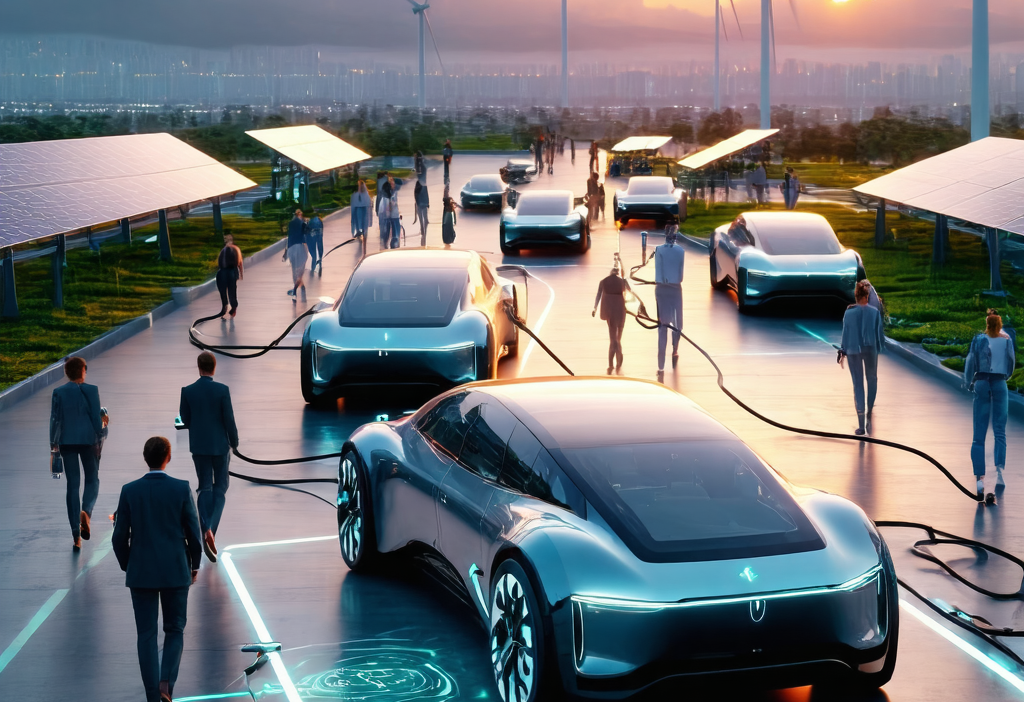The Future of Electric Vehicles in 2025: A Roadmap to Sustainability
As we stand at the brink of 2025, the world of transportation is undergoing a seismic shift. Electric vehicles (EVs) are no longer just a niche market; they’re becoming the norm. This blog dives into the transformative journey of EVs in 2025, exploring technological advancements, government policies, consumer adoption, and industry trends that are reshaping our roads.
The Technological Leap: Innovations Driving the EV Revolution
2025 marks a pivotal year for EV technology. Here’s what’s on the horizon:
- Solid-state batteries: These wonder batteries promise longer range, faster charging, and improved safety compared to traditional lithium-ion batteries. Imagine driving from New York to Los Angeles on a single charge!
- Wireless charging lanes: Forget about plugging in your car. Roads equipped with wireless charging technology will soon allow EVs to charge as they drive, making long trips seamless.
- AI-powered energy management: Advanced algorithms will optimize how EVs consume and store energy, ensuring maximum efficiency and range.
These innovations aren’t just incremental improvements; they’re game-changers that are redefining what it means to own an electric vehicle.
Government Policies: The Push Toward a Greener Future
Governments worldwide are pulling out all the stops to accelerate the adoption of EVs. In 2025, we’re seeing:
- Ban on new gas-powered cars: Several countries, including the UK and France, have announced plans to phase out new internal combustion engine vehicles by 2030, with significant milestones in 2025.
- Massive investments in charging infrastructure: Governments are pouring billions into building EV charging networks. For instance, the EU’s “Recharge” initiative aims to install 1 million public charging stations by 2025.
- Tax incentives and subsidies: To make EVs more affordable, governments are offering tax breaks, rebates, and direct subsidies. The U.S., for example, has extended its federal tax credit program to encourage purchases of electric vehicles.
These policies aren’t just symbolic; they’re creating a regulatory environment that’s pushing automakers and consumers alike toward a greener future.
Consumer Adoption: The Shift in Buying Habits
The EV revolution isn’t just about technology and policy—it’s also about changing consumer behavior. In 2025, we’re witnessing a significant shift in how people view and purchase vehicles:
- Rising demand for EVs: Global EV sales hit a record high in 2023, and this momentum is expected to continue through 2025. Consumers are increasingly drawn to the environmental benefits, lower operating costs, and cutting-edge features of electric vehicles.
- Expansion into new markets: Once confined to developed nations, EVs are now making inroads in emerging markets like India and Southeast Asia. Companies like Tesla, BYD, and others are ramping up production to meet this growing demand.
- The role of car-sharing and mobility services: Ride-sharing platforms and car-sharing services are playing a crucial role in promoting EV adoption. By offering affordable access to electric vehicles, these services are helping to normalize their use among the broader population.
Consumers today are more environmentally conscious than ever before, and this mindset is driving the widespread acceptance of electric vehicles.
The Industry Response: Automakers Racing Toward Electrification
The auto industry is in a state of flux as companies scramble to keep pace with the EV revolution. In 2025, we’re seeing:
- Mass electrification of vehicle fleets: Major automakers like Toyota, General Motors, and Ford are transitioning their production lines to focus heavily on electric vehicles. Even traditional luxury brands like Mercedes-Benz and BMW are prioritizing EVs in their product pipelines.
- New entrants disrupting the market: Startups like Rivian and Lucid Motors are challenging established automakers with innovative designs and cutting-edge technology. These companies are proving that the future of mobility doesn’t have to come from traditional car manufacturers.
- Collaborations and partnerships: To stay competitive, automakers are forming alliances with tech companies, battery manufacturers, and even governments. For example, Toyota has partnered with CATL, a leading battery maker, to develop next-generation energy storage solutions.
The industry landscape is evolving rapidly, with innovation and collaboration at its core. This dynamic environment ensures that the EV revolution remains unstoppable.
Challenges Ahead: Overcoming Barriers to EV Adoption
Despite the progress made so far, several challenges still loom large on the horizon:
- Battery supply chain issues: The demand for raw materials like lithium and cobalt is outpacing supply. This has led to concerns about sustainability and ethical sourcing. Efforts are underway to develop more sustainable mining practices and explore alternative battery chemistries.
- Charging infrastructure gaps: While significant investments are being made in charging networks, there’s still a long way to go to achieve comprehensive coverage. Rural areas and less-developed regions often lag behind urban centers in terms of EV infrastructure availability.
- High upfront costs: Despite falling battery prices and government incentives, EVs remain more expensive than their gas-powered counterparts. This barrier is particularly challenging for lower-income consumers who are looking to make the switch.
Addressing these challenges will be crucial to ensuring that the EV revolution continues its momentum in 2025 and beyond.
The Road Ahead: Predictions for the Future of Electric Vehicles
As we look toward the future, several trends are likely to shape the evolution of electric vehicles:
- Mass adoption by 2030: Experts predict that EVs will dominate new car sales by the end of this decade. This shift will be driven by continued technological advancements, supportive government policies, and changing consumer preferences.
- The rise of autonomous vehicles: Electric vehicles are becoming the backbone for autonomous driving technology. As self-driving cars become more prevalent, they’ll further accelerate the adoption of EVs due to their inherent compatibility with advanced systems.
- Integration with renewable energy grids: The synergy between electric vehicles and renewable energy sources will deepen in the coming years. Solar and wind power are expected to play a larger role in charging infrastructure, creating a more sustainable ecosystem for EVs.
The future of transportation is undeniably electric. As we navigate the challenges and opportunities ahead, one thing is clear: the era of gas-powered cars is coming to an end, and the age of electric vehicles is just beginning.
Conclusion: Embracing a Sustainable Future
Electric vehicles are more than just a technological advancement; they represent a fundamental shift in how we approach transportation and energy consumption. By embracing innovation, fostering collaboration, and addressing the challenges head-on, we can ensure that this transition is smooth and successful.
The journey toward widespread EV adoption has only just begun, but the momentum is undeniable. As we move forward, let’s continue to prioritize sustainability, affordability, and accessibility so that everyone can benefit from the benefits of electric mobility.
The future is electric, and it’s brighter than ever.





